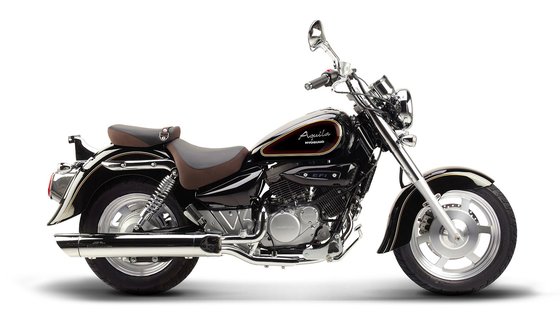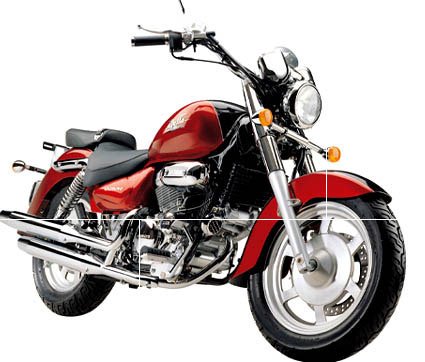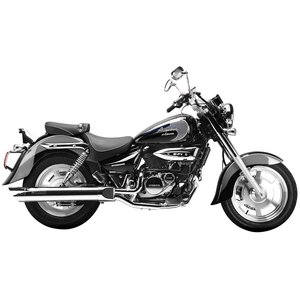Hyosung GV 250 Aquila (2000–2017): A Testament to Accessible Cruiser Spirit

Introduction
The Hyosung GV 250 Aquila is a motorcycle that defies expectations. Produced for nearly two decades, this Korean cruiser carved out a niche as an approachable, V-twin-powered machine for riders seeking classic styling without the bulk of larger displacement bikes. From its debut in 2000 to its final iterations in 2017, the Aquila remained a steadfast option for urban commuters, beginners, and riders who prioritized simplicity over brute power.
During a test ride on a well-maintained 2014 model, the Aquila’s charm became clear: it’s a motorcycle that prioritizes rider comfort and ease of use. The low-slung seat, throaty V-twin rumble, and forgiving ergonomics make it feel like a trusted companion rather than a high-strung performance machine. While it won’t set speed records, its longevity in the market speaks to its reliability and niche appeal.
Design: Classic Cruiser Aesthetics with Practical Tweaks

The Aquila’s design adheres to cruiser conventions—long wheelbase, swept-back handlebars, and a teardrop fuel tank. Early models (2000–2011) featured carbureted engines and a slightly boxier silhouette, while post-2012 variants adopted fuel injection, smoother body lines, and modernized air intakes. The seat height—ranging from 690–710 mm (27.2–28.0 inches)—ensures even shorter riders can plant both feet firmly, a boon in stop-and-go traffic.
Hyosung’s choice of a steel double-cradle frame strikes a balance between rigidity and weight distribution. The 150/80-15 rear tire and 110/90-16 front tire provide a planted stance, though the narrow front hoop can feel tentative on uneven surfaces. Over the years, color schemes evolved from basic blacks and silvers to bold two-tone combinations like black/orange and red/black, giving the Aquila a touch of personality in parking lots.
Engine & Performance: A Friendly V-Twin for Everyday Riding

At the heart of the Aquila lies a 249 cc, 75° V-twin engine—a rarity in the 250 cc class dominated by single-cylinders and parallel twins. Early models produced up to 34 HP, though later fuel-injected versions settled around 25–28 HP (18.6–20.9 kW) to meet emissions standards. Torque figures hover near 22 Nm (16.2 lb-ft), delivered predictably between 7,300–7,500 RPM.
The engine’s character is its strongest asset. The V-twin’s lumpy idle and throaty exhaust note mimic larger cruisers, while the five-speed transmission shifts with deliberate, if not sporty, precision. On open roads, the Aquila cruises comfortably at 100–110 km/h (62–68 mph), though accelerating past 130 km/h (81 mph) requires patience. Fuel efficiency is a highlight: expect 2.9–3.2 L/100 km (73–88 mpg), translating to a 350–400 km (217–248 mi) range from its 14–15 L (3.7–3.96 gal) tank.
Handling & Comfort: City-Friendly, Highway-Capable

The Aquila’s 1,435–1,515 mm (56.5–59.6 in) wheelbase and 155–176 kg (341–388 lb) curb weight make it nimble in urban settings. The suspension—41 mm telescopic forks up front and preload-adjustable dual shocks at the rear—is tuned for compliance over potholes but can feel underdamped on aggressive cornering.
Braking is adequate, with a single 300 mm front disc (dual-piston caliper post-2010) and a rear drum brake. While not designed for spirited riding, the setup suffices for casual use. Taller riders (over 180 cm / 5’11”) might find the footpegs too forward and the handlebars too low for long hauls, but the upright seating position minimizes wrist strain.
Competition: How the Aquila Stacks Up

The GV 250 Aquila’s closest rivals include:
Honda Rebel 250
- Engine: Parallel-twin, smoother but less characterful.
- Pros: Legendary reliability, lighter at 149 kg (328 lb).
- Cons: Bland exhaust note, dated styling until 2016.
Yamaha V Star 250
- Engine: Air-cooled V-twin, similar power but heavier at 152 kg (335 lb).
- Pros: Superior aftermarket support, more highway-stable.
- Cons: Higher seat (27.6 in / 700 mm), less fuel-efficient.
Suzuki GZ250 Marauder
- Engine: Single-cylinder, simpler but vibrations at high RPM.
- Pros: Lower maintenance, cheaper parts.
- Cons: Lacks the V-twin’s aesthetic appeal.
Aquila’s Edge: Its DOHC V-twin offers a unique blend of cruiser charisma and mechanical sophistication in the 250 cc class. While Japanese rivals excel in reliability, the Aquila appeals to riders craving a small-displacement cruiser that feels bigger than it is.
Maintenance: Keeping Your Aquila Road-Ready

The Aquila’s straightforward mechanics make it a DIY-friendly project. Key considerations:
Valve Adjustments
- Intake: 0.10–0.20 mm (0.004–0.008 in) cold.
- Exhaust: 0.20–0.30 mm (0.008–0.012 in) cold.
- Frequency: Every 6,000 km (3,728 mi).
Oil Changes
- Capacity: 1.5 L (1.6 qt) with filter.
- Recommendation: Semi-synthetic 10W-40 for improved heat management.
Chain Care
- Specs: 116-link chain, 14/46 sprockets.
- Maintenance: Clean and lubricate every 500 km (311 mi); tension at 25–35 mm (1.0–1.4 in).
Tire Pressures
- Front: 1.7 bar (25 psi).
- Rear: 2.0–2.25 bar (29–33 psi).
Carburetor Tuning (Pre-2012 Models)
- Mikuni BDS26: Regular cleaning prevents clogging. Consider upgrading to KN air filters for better airflow.
Pro Tip: Upgrade to NGK CR8EIX iridium spark plugs for smoother cold starts and longevity. MOTOPARTS.store stocks OEM-spec parts and performance upgrades like aftermarket exhausts and ergonomic handlebars.
Conclusion: A Small Cruiser with Lasting Appeal

The Hyosung GV 250 Aquila isn’t a motorcycle that demands attention—it earns it through sheer dependability and rider-friendly design. While its specs won’t thrill adrenaline junkies, its V-twin heartbeat and approachable ergonomics make it a compelling choice for new riders and urban commuters.
For owners, the Aquila’s longevity hinges on regular care. Whether you’re refreshing its suspension with aftermarket shocks or personalizing it with saddlebags, MOTOPARTS.store offers the tools and parts to keep your Aquila running—and turning heads—for years to come.




Specifications sheet
| Engine | |
|---|---|
| Stroke: | Four-stroke |
| Max power: | 25 kW | 34.0 hp |
| Max torque: | 22 Nm |
| Fuel system: | Carburettor (2x Mikuni BDS26) / Electronic Fuel Injection (EFI) depending on model year |
| Max power @: | 10000 rpm |
| Displacement: | 249 ccm |
| Max torque @: | 7500 rpm |
| Bore x Stroke: | 57.0 x 48.8 mm |
| Configuration: | V |
| Cooling system: | Oil & air |
| Compression ratio: | 10.3:1 (11.0:1 on EFI models) |
| Lubrication system: | Wet sump |
| Number of cylinders: | 2 |
| Valves per cylinder: | 4 |
| Dimensions | |
|---|---|
| Wheelbase: | 1515 mm (59.6 in) |
| Dry weight: | 155 |
| Wet weight: | 182 |
| Seat height: | 710 mm (28.0 in) |
| Overall width: | 875 mm (34.4 in) |
| Overall height: | 1096 mm (43.1 in) |
| Overall length: | 2282 mm (89.8 in) |
| Ground clearance: | 150 mm (5.9 in) |
| Fuel tank capacity: | 14 L (3.7 US gal) |
| Drivetrain | |
|---|---|
| Final drive: | chain |
| Chain length: | 118 |
| Transmission: | 5-speed |
| Rear sprocket: | 47 |
| Front sprocket: | 15 |
| Maintenance | |
|---|---|
| Rear tire: | 150/80-15 |
| Engine oil: | 10W40 |
| Front tire: | 110/90-16 |
| Idle speed: | 1500 ± 50 RPM |
| Brake fluid: | DOT 4 |
| Spark plugs: | NGK CR8E or NGK CR8EIX |
| Spark plug gap: | 0.8 |
| Forks oil capacity: | 0.5 |
| Engine oil capacity: | 1.5 |
| Final drive chain type: | 520 chain |
| Engine oil change interval: | Every 5000 km or 2 years |
| Valve clearance (intake, cold): | 0.10–0.20 mm |
| Valve clearance check interval: | 24,000 km / 15,000 mi |
| Valve clearance (exhaust, cold): | 0.20–0.30 mm |
| Recommended tire pressure (rear): | 2.5 bar (36 psi) solo, 2.8 bar (41 psi) with passenger |
| Recommended tire pressure (front): | 2.25 bar (33 psi) |
| Chassis and Suspension | |
|---|---|
| Frame: | Steel double pipe |
| Rear tire: | 150/80-15 |
| Front tire: | 110/90-16 |
| Rear brakes: | Drum |
| Front brakes: | Single 310 mm disc, 2-piston caliper |
| Rear suspension: | Swing arm with hydraulic double shock absorber (preload adjustable) |
| Front suspension: | 41mm telescopic fork |
| Rake (fork angle): | 25.0° |


















